What do you think is the best way to actually know the place, and the people living there? You answer might be the culture, the cuisine, the traditional customs, etc. Is there something missing? Knowing the countries and the destinations you set foot on through the history that the people there have gone through is a brilliant and appealing option.
And if you already have plans to visit Ho Chi Minh city, I recommend you look at our list of popular historical destinations here to find out more:
Top 7 famous historical destinations in Ho Chi Minh city
Independence Palace
History path
In 1868, 10 years after invading Vietnam, the French government began to design and build in the center of Saigon a mansion as a residence for the Governor of Cochin-china (nowaday Southern Vietnam), when the construction was completed, it was called Norodom Palace.
Later on, this palace was used as a workplace or headquarters of the enemy’s military of the country that occupied Indochina or Vietnam: the Japanese fascist (March 9, 1945), France (September 1945).
On September 7, 1954, Palace Norodom was handed over between the representative of the French government, General Paul Ely and the representative of Saigon government Prime Minister Ngo Dinh Diem, a henchman of French government.
By historical Ho Chi Minh campaign, 10:45 on 30/4/1975, Vietnamese had rammed the side gate of the Independence Palace, then the tank bearing number 390 had knocked the main gate straight into the Palace. 11:30 on the same day, Bui Quang Than – Captain of 843 tank commander lowered the 3-striped flag as a sign of independence.
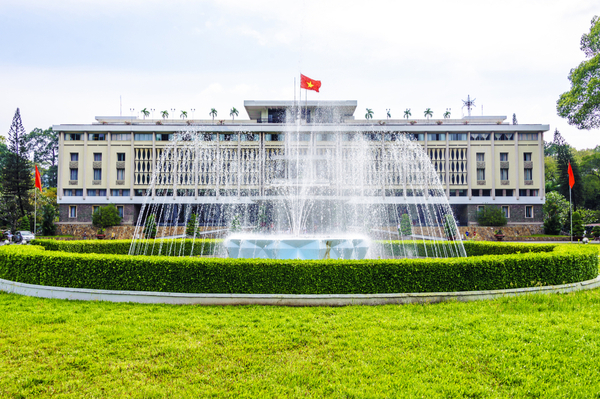
Nowadays condition
Today, the Independence Palace is a special national monument that is visited by many domestic and foreign tourists
On the first floor, the exhibition introduces the construction of the Norodom Palace and depicts a part of Saigon life during the French colonial. The staircase area reviews some important historical events of Vietnam in the general context of the world from 1937 to 1954. The second floor introduces the establishment and collapse of the Ngo Dinh Diem government along with the process of building the Independence
The destination includes traditional and modern displays, in which the use of technological equipment is a key highlight such as projectors, touch screens, headsets. They hope to display “Tu Dinh Norodom to Independence Palace 1868-1966 ” will share with the public historical memories in a whole new way, creating a more attractive and interesting experience for visitors.
Address: 135 Nam Ky Khoi Nghia, Ben Thanh street, Quan 1 district, Ho Chi Minh City
Opening:
-In the morning: 7:30 a.m. – 11:30 a.m
– In the afternoon: 1:00 p.m. 5:30 p.m.
Saigon Central Post Office
History path:
After defeating Gia Dinh citadel and capturing Saigon, France established a communication system. In 1860, France built a “Saigon Steel Wire Department” (Saigon Central Post Office) right in the center of the city.
It was designed by Alfred Foulhoux, but is often erroneously credited as being the work of Gustave Eiffel or a collaboration between Foulhoux and Hanoi-based Auguste Henri Vildieu.
In 1864, the first letters with the “stork” stamp (the first stamps to appear in Vietnam) were sent from Saigon to everywhere in the world. In 1886, Saigon Central Post Office was rebuilt, because it was not enough to meet the increasing demand of the people. In 1891, the new headquarters of Central Post Office inaugurated officially.
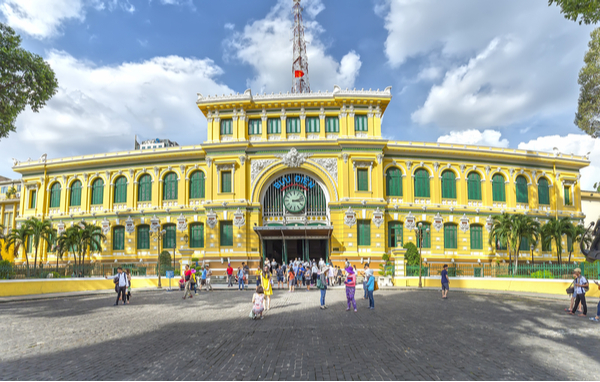
Nowadays condition
Today, the Central Post Office along with Ben Thanh Market, Ho Chi Minh City Opera House, Notre Dame Cathedral have created a special monument complex, becoming icons that are irreplaceable in the hearts of Saigon people.
Over 130 years of history, up to now, Saigon Post Office still retains the original Asian – European architecture, maintains the post and telecommunications activities and has become an attractive tourist attraction of Saigon.
On both sides of the corridor near the main entrance of the building, there are many souvenir shops selling variety of souvenir products, postcards to Saigon Post Office as well as Vietnam in general.
Address: 2 on the Square of Paris Commune, Ben Nghe street, District 1, Ho Chi Minh city
Opening hours: 7:00 a.m. – 7:00 p.m.
Ticket fee: Free
Cu Chi Tunnels
History path
Cu Chi Tunnels were formed during the war against the French colonialists (1946 – 1948).
During this time, the militia and people of Tan Phu and Phuoc Vinh dug short, simple structures to hide confidential documents and weapons.
Then, residents of the area have dug tunnels separately to avoid the attack of the invaders. At first, each village built a separate tunnel, then due to the need to travel between the tunnels of the villages, the tunnel system was connected to form a continuous and complex tunnel system. Later, the tunnel expanded to many places, especially 6 communes of the north of Cu Chi and the structure of tunnels was improved to become a place to hide forces, when the battle was going on, Vietnamese people could contact and support each other.
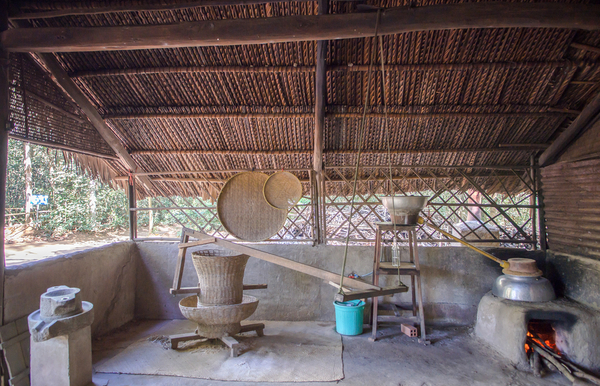
Nowadays condition
Cu Chi Tunnels is currently the main attraction on your journey. you will experience the underground life like Vietnamese ancestors during the war when visiting and exploring every corner of the 120-meter-long tunnel system with 2 floors, eating the dishes that the locals used to eat when they were down the tunnel.
According to the experience of visiting Cu Chi Tunnels shared by some travelers, the most interesting thing when discovering Cu Chi Tunnels is that you will be eating potatoes, cassava and sesame bulbs dipped with sesame salt in Hoang Cam kitchen area after when the end of the tunnel.
One more interesting here is that you can try shooting in shooting range.
Here you are not only instructed on how to assemble the gun and also try shooting. Entrance fee is 50,000 VND / person / 60 minutes. To participate in the shooting trial you will have to buy and 3000 VND / bullet.
Address:
Cu Chi Tunnels are preserved in two locations:
– Ben Duoc Tunnels in Phu Hiep Hamlet, Phu My Hung Commune, Cu Chi District, Ho Chi Minh City.
– Ben Dinh Tunnels in Ben Dinh Hamlet, Nhuan Duc Commune, Cu Chi District, Ho Chi Minh City
Opening hours: 7:00 a.m. – 5:00 p.m. every day of the week.
Ticket fee: 80.000 VNĐ/person (not including other experience activities)
Nha Rong Harbour
History path
Nha Rong Harbour used to be the headquarters of transport company in Saigon from 1864 to 1955. It is called Nha Rong Harbour because there was a building with Western architecture but on the top were two dragons, so people called it Nha Rong (The Dragon House). This is also the first project built by the French after capturing Saigon.
However, this place is well known because of an important event for Vietnamese people. On June 5, 1911, young Nguyen Tat Thanh (later known as Ho Chi Minh) boarded the Amiral Latouche Tréville as a kitchen assistant to be able to travel to Europe, starting the revolutionary journey. Therefore, since 1975, the architectural monuments complex of Nha Rong commercial port has been rebuilt by the State of Vietnam as a Ho Chi Minh memorial area.
Since 1954, after the French was defeated in Indochina, Nha Rong wharf was assigned to the South Vietnamese government for management.
During the years of the war against France and America, this place was chosen as the venue for many protests, strikes of Vietnamese people.
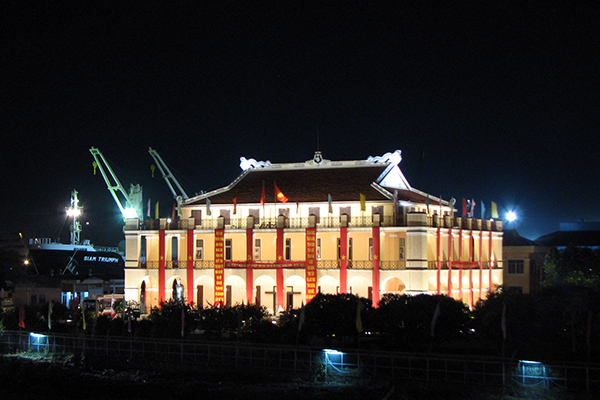
Nowadays condition
The Dragon House is one of the rare French architectural works that is still preserved in Saigon. You will see an ancient building with Asian and European architecture combined.
From 1975 to now, the headquarters of Nha Rong commercial port was rebuilt by the Vietnamese government to become Ho Chi Minh memorial, until 1995, this relic area continued to be renovated and changed to Ho Chi Minh Museum.
Address: 1 Nguyen Tat Thanh Street, District 4, Ho Chi Minh City,
Opening hours:
Morning from 7:30 to 11:30, afternoon from 13:30 to 17:30
The opening day is from Tuesday to Sunday weekly.
Ticket fee: 25.000 VND/ person
War Remnants Museum
History path
During the Nguyen Dynasty (in the 19th century), the location of the War Remnants Museum was the building of Khai Tuong Pagoda. The temple was completely demolished by the French government to replace it as a mansion.
In the later period, this place became a gynecological hospital, a lawyer’s office, etc. Only after 1975, when the country was liberated from the US imperialists, this place became a museum, recorded. historical events, war traces or exhibits related to the war against aggressors.
Nowadays condition
The museum currently holds more than 20,000 documents and artifacts
The first floor of the museum is the ticket office, multipurpose room, and the world room. One of the outstanding stops on the first floor is the “Tiger Cages” – a type of detention in Con Dao prison. The tiger cages are considered the most terrible torture place of the US army for patriotic prisoners.
The first floor is also a place to display large artifacts such as aircraft, tanks or artillery pieces of soldiers or American soldiers in the war.
The ground floor of the museum is a world of images, historical landmarks showing a whole time of mournful but epic history. There many fascinating topics such as The World with Vietnam War or The Story of the Victims of Agent Orange
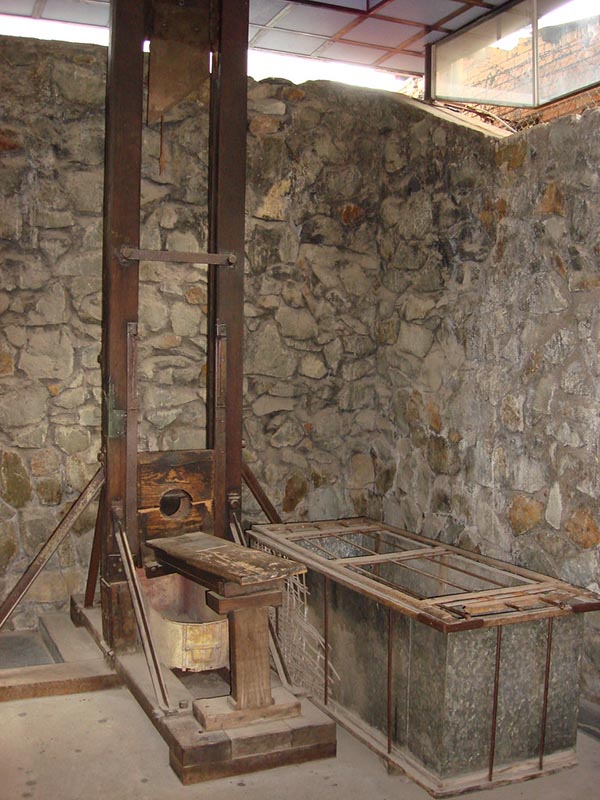
Address: 28, Vo Van Tan Street, Ward 6, District 3, City Ho Chi Minh.
Opening hours: from 7:30 a.m. – 6:00 p.m., all days of the week (including Holidays and New Year).
Ben Thanh market
History path
The original Ben Thanh Market was built with bricks, wooden ribs, and thatched roofs. It was described as “a busy residential market along the river.
It gathered hundreds of goods, along the river wharf, large and small boats to come. However, after the rebellion of Le Van Khoi (1833-1835), Quy was defeated, the Ben Thanh market street was no longer as busy as before.
In February 1859, France occupied Gia Dinh citadel and two days later, Vietnamese soldiers organized a fire to burn down the city, of course Ben Thanh Market was also burned.
After being firmly established on the land of Cochin-chine (nowaday Southern Vietnam), in 1860, the French had to rebuild Ben Thanh Market in the old place The market was built with brick pillars, iron ribs, roofed with tiles, all with five compartments: foodstuff, fish stall, meat stall, food stall and grocery store..
Ben Thanh Market is always bustling. In 1887, the French filled the canal and merged the two roads to form a Charner Boulevard. The market became increasingly crowded with shops mostly of Chinese, Indians and French. However, around mid-1911, the market became old and fell into a state of collapse
At the same time, the French also chose a location to build a larger new market to serve the growing business needs. The chosen location was near the My Tho train station (now known as Saigon Bus Station), which is the site of today’s Ben Thanh Market.
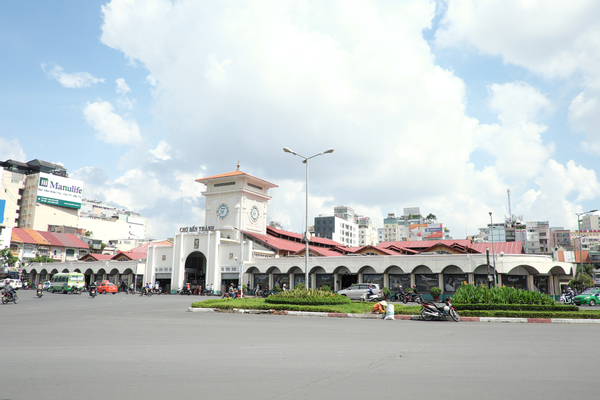
Nowadays condition
The market has become a witness to the city’s ups and downs in the past hundred years and the development of a commercial city.
In recent years, Ben Thanh Market is an indispensable place for any tour to Ho Chi Minh City. Ho Chi Minh. Visitors come to the market not just to buy goods or souvenirs but also to find a characteristic personality shown in the daily life of a city because the market is the most obvious place to show it.
Ben Thanh Market has a total area of 13,056m², an average of about 10,000 daily visitors to buy and sell. The market has 1,446 stalls, 6,000 small businesses, 5 businesses, with four main doors and 12 auxiliary doors radiating in four directions.
Cua Dong (Phan Boi Chau street) attracts customers by colorful cosmetics and confectionery.
Cua Tay (Phan Chu Trinh street) is a place that attracts women because of the variety of styles and sizes of shoes, fine arts, souvenirs.
Cua Nam (overlooking Quach Thi Trang square) with the symbol of a three-sided clock tower, is the main gate, inside the cage house is the place to sell cloth items and dried food.
Cua Bac (on Le Thanh Ton Street) is dazzling with stalls of fresh flowers and fruits inviting passers-by.
Ben Thanh Market is also very active at night, starting at 7pm, the stalls pour into Phan Boi Chau and Phan Chu Trinh streets on the side of the market with fine art, souvenir, clothes and special stalls. is the restaurant.
The soul of Ben Thanh market is located in the cage, where urban life takes place most vividly through the intimate communication between people and people.
Address: center of District 1, on 4 streets Phan Chu Trinh, Phan Boi Chau, Luu Van Lang and Nguyen An Ninh opposite East and West gates
Operating time: Open from 4 a.m. and rom 7 p.m., shops inside the main market close, making way for the arrival of Ben Thanh Night Market,
Ticket fee: Free
Notre Dame Cathedral
History path
Notre Dame Cathedral, officially known as the Basilica of Our Lady of the Immaculate Conception, its French name is Cathédrale Notre-Dame de Saigon.
During the war of the French colonialists in Vietnam, shortly after capturing Saigon, France established a church to serve as a place of worship for Catholics in the expedition army.
Notre Dame Cathedral was built in 3 years. In April 1880, on the occasion of Easter, the dedication and inauguration ceremony of the Notre Dame Cathedral was organized by the late Colombert and was attended by the Cochin-china Governor Le Myre de Vilers.
The church was built according to the design of architect Bourard, an expert on religious architectural works.
In 1895, the church built two more bell towers, each tower was 57.6m high and the two towers had 6 large copper bells weighing 28.85 tons. On the top of the tower is attached a cross 3.50 meters high, 2 meters across, weighing 600 kg. Overall height from the ground to the top of the cross is 60.50m.
In 1960, the Holy See established Vietnamese clergy with three archbishops in Hanoi, Hue and Saigon. The church became the cathedral of Archbishop of Saigon to this day.
Nowadays condition
This is the cathedral of the archdiocese of Ho Chi Minh City today.
From the beginning of 2018, Notre Dame Cathedral was officially started to renovate after 138 years of age in the heart of Ho Chi Minh City. This particular religious building is an “architectural version” of the Notre Dame Cathedral in Paris (France).
Address: 1, Cong Xa Paris, Ben Nghe street, District 1.
Opening time: 5:30 a.m. – 5:00 p.m.
Ticket fee: Free
I think even if you are a history buff or not, those above spots will satisfy your curiosity about Vietnam and the people here with thorough insights into a country known for long-lasting epic history.





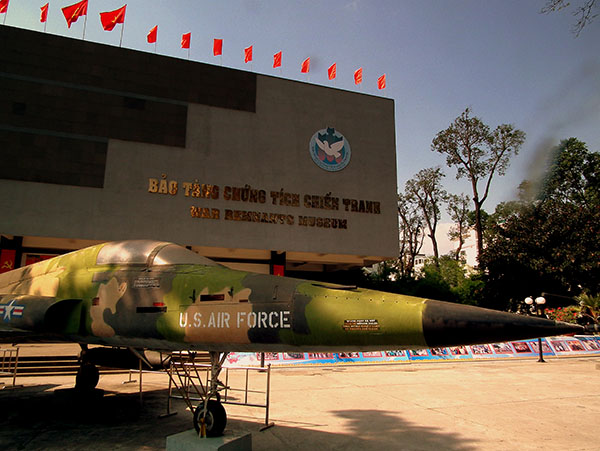
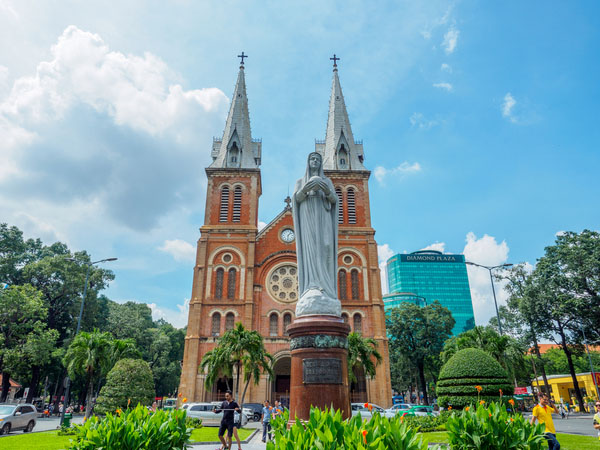

Comments